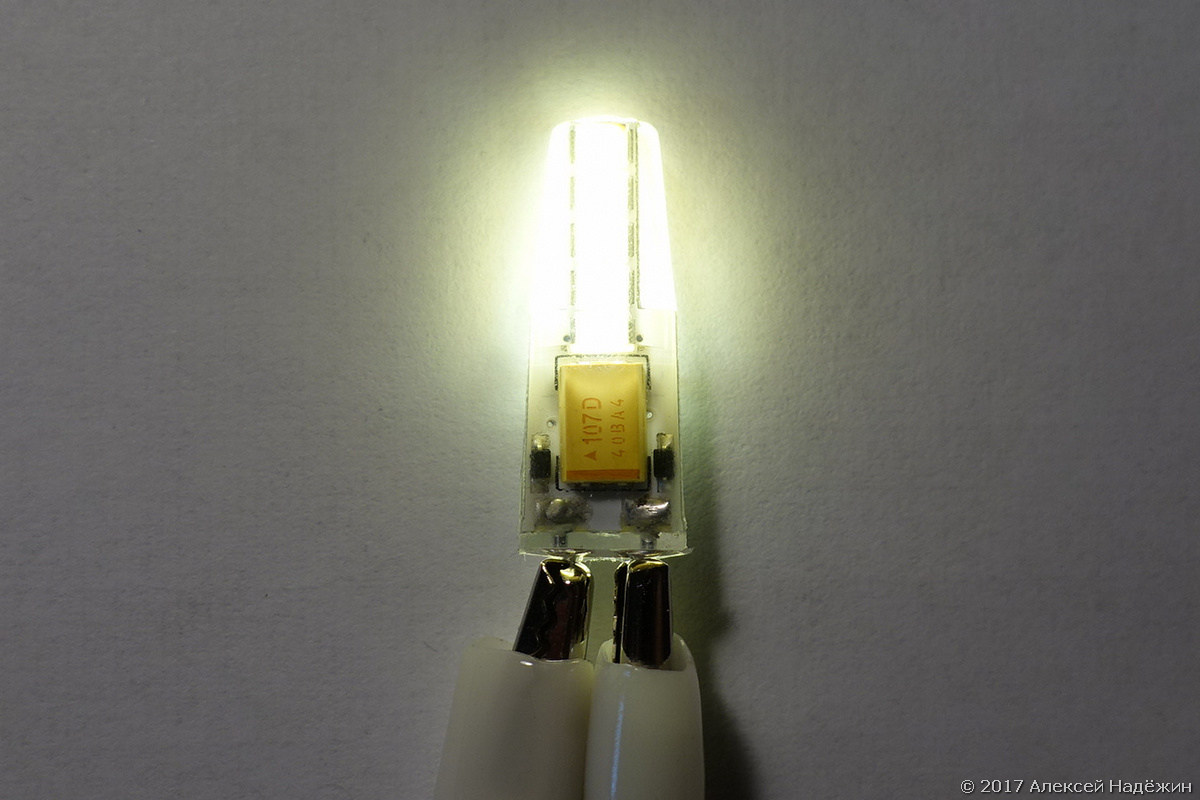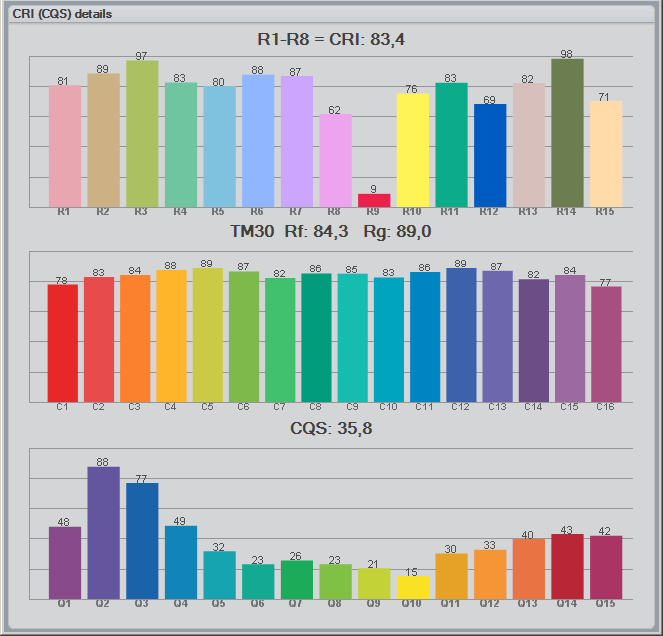CRI: I have bad news for you.
Everyone who understood the quality of light from LED lamps and everyone who read my articles about LED lamps is aware of such a parameter as the color rendering index (CRI, aka Ra). It is believed that high-quality living light should have a CRI of at least 80.
Recently, I ran into a lamp whose CRI was quite decent — 83.4, but it gave a very unpleasant greenish light.

I tried to figure out what was wrong with her.
Color rendering index or color rendering index - CRI ( en.wikipedia.org/wiki/Index_transfer ) - a parameter characterizing the level of conformity of the natural color of the body to the apparent (apparent) color of this body when it was illuminated with this light source was proposed in 1965.
')
CRI is the average transmission level of the eight colors R1-R8.

Sometimes, in addition to CRI, the red color transfer index R9 is indicated and measured. This index affects the quality of the transmission of the tone of human skin. At lamptest.ru, the measured index R9 is listed on the card of each lamp.

Back in 2007, the International Commission on Illumination noted that “... the color rendering index is usually not applicable for predicting the color rendition parameters of a set of light sources, if this set includes white LEDs,” but it turned out that all manufacturers of LED lamps use exactly CRI.
In 2010, for a more accurate assessment of the quality of color transmission, the Color Quality Scale (CQS) method was developed, evaluating the quality of light by fifteen colors.

In 2015, the TM-30-15 standard was developed, which assesses the quality of light by 99 colors.

In good lamps, the values of all three indices are approximately equal.

Now back to the lamp Gauss 207707102 190Lm 2W 2700K G4 12V, because of which I started all this research. Her color indexes look amazing.

The CRI value is quite high - 83.4, TM30 Rf - 84.3, but the CQS is very low - 35.8. It seems that the sly Chinese has mixed the phosphor so that exactly those 8 colors that are taken into account when measuring CRI are well transmitted. Surprisingly, the result, such as the most advanced TM30 index, also turned out to be high.
I note that of all 1244 lamps, the parameters of which I measured, only one had such a low level of the CQS index. Even the worst nameless Chinese light bulbs with CRI 60, CQS is at least 50.
I began to study the CQS values of the lamps and found out that there are quite a lot of lamps with a CRI greater than 80, and the CQS value is slightly above 70, but the light of such lamps is visually quite comfortable. But some of the lamps with a CRI of more than 80, CQS was about 60 and the light of such lamps is visually greenish or yellowish.
The question arises, what to do about it. Probably you have to add the value of CQS to lamptest and take it into account when calculating the final rating of the lamps, so that it could not happen that the lamp with a high CRI, but with uncomfortable light was highly appreciated.
© 2017, Alexey Nadyozhin
Recently, I ran into a lamp whose CRI was quite decent — 83.4, but it gave a very unpleasant greenish light.

I tried to figure out what was wrong with her.
Color rendering index or color rendering index - CRI ( en.wikipedia.org/wiki/Index_transfer ) - a parameter characterizing the level of conformity of the natural color of the body to the apparent (apparent) color of this body when it was illuminated with this light source was proposed in 1965.
')
CRI is the average transmission level of the eight colors R1-R8.

Sometimes, in addition to CRI, the red color transfer index R9 is indicated and measured. This index affects the quality of the transmission of the tone of human skin. At lamptest.ru, the measured index R9 is listed on the card of each lamp.

Back in 2007, the International Commission on Illumination noted that “... the color rendering index is usually not applicable for predicting the color rendition parameters of a set of light sources, if this set includes white LEDs,” but it turned out that all manufacturers of LED lamps use exactly CRI.
In 2010, for a more accurate assessment of the quality of color transmission, the Color Quality Scale (CQS) method was developed, evaluating the quality of light by fifteen colors.

In 2015, the TM-30-15 standard was developed, which assesses the quality of light by 99 colors.

In good lamps, the values of all three indices are approximately equal.

Now back to the lamp Gauss 207707102 190Lm 2W 2700K G4 12V, because of which I started all this research. Her color indexes look amazing.

The CRI value is quite high - 83.4, TM30 Rf - 84.3, but the CQS is very low - 35.8. It seems that the sly Chinese has mixed the phosphor so that exactly those 8 colors that are taken into account when measuring CRI are well transmitted. Surprisingly, the result, such as the most advanced TM30 index, also turned out to be high.
I note that of all 1244 lamps, the parameters of which I measured, only one had such a low level of the CQS index. Even the worst nameless Chinese light bulbs with CRI 60, CQS is at least 50.
I began to study the CQS values of the lamps and found out that there are quite a lot of lamps with a CRI greater than 80, and the CQS value is slightly above 70, but the light of such lamps is visually quite comfortable. But some of the lamps with a CRI of more than 80, CQS was about 60 and the light of such lamps is visually greenish or yellowish.
The question arises, what to do about it. Probably you have to add the value of CQS to lamptest and take it into account when calculating the final rating of the lamps, so that it could not happen that the lamp with a high CRI, but with uncomfortable light was highly appreciated.
PS: I am looking for the development of the lamptest.ru project
1. PHP-programmer who is ready to help with the completion of the site.
2. Assistants, ready to engage in the purchase and return of lamps in stores.
3. Laboratories with a photometric ball, ready to measure for free a luminous flux of a dozen of my samples (to confirm the accuracy of my measurements).
4. A person who made the formula for calculating the quality assessment of lamps in Excel (I’ve done everything, I can’t find any contacts).
2. Assistants, ready to engage in the purchase and return of lamps in stores.
3. Laboratories with a photometric ball, ready to measure for free a luminous flux of a dozen of my samples (to confirm the accuracy of my measurements).
4. A person who made the formula for calculating the quality assessment of lamps in Excel (I’ve done everything, I can’t find any contacts).
© 2017, Alexey Nadyozhin
Source: https://habr.com/ru/post/373093/
All Articles